#Northern Australia Food
Explore tagged Tumblr posts
Text

Check Australian Farmgate Output Insights For Agriculture Production
Explore insights from NFF's Darwin forum and Australian Farmgate Output release a plan of $100M for agriculture production development in Australia. Check out the complete roadmap in our blog and visit our website to know the benefits of farm sheds.
#Ag production outlined in Darwin#Australian Farmgate output#Northern Australia Food#National Farmer’s Federation#Agriculture production#farm shed#agriculture shed
0 notes
Text
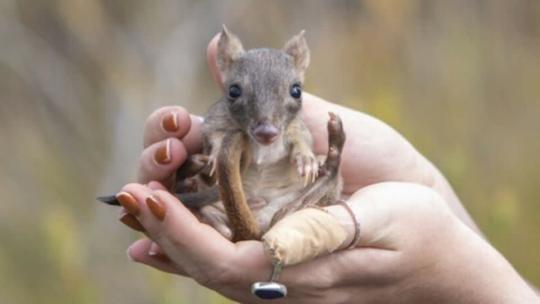
Brush-tailed bettongs (also known as woylies) once inhabited more than 60% of mainland Australia. However, the European colonization of the country brought with it predatory feral cats and foxes, and the destruction of much of the animal’s native grassland and woodland habitats.
Between 1999 and 2010, the species’ population size declined by 90% – a drastic drop that some research suggests may have resulted from the spread of blood parasites, alongside other factors. Today, the brush-tailed bettong is limited to just a few islands and isolated mainland pockets in Southwestern Australia: a mere 1% of its former range.
Marna Banggara
“We are on a mission, if you like, to bring back some of these native species that have gone missing in our landscape since European colonization,” says Derek Sandow, project manager of Marna Banggara, an initiative dedicated to restoring some of the Yorke Peninsula’s historic ecological diversity.
Formerly known as the “Great Southern Ark,” the project, which was launched in 2019 by the Northern and Yorke Landscape Board, was renamed to honor the region’s native Narungga people, who are heavily involved with the initiative.
“Marna in our language means good, prosperous, healthy, and Banggara means country,” says Garry Goldsmith, a member of the Narungga community who works on the project.
The team initially erected a 25-kilometer predator-control fence across the narrow part of the Yorke Peninsula to create a 150,000-hectare safe haven for the first species to be brought back: the brush-tailed bettong, known as yalgiri to the Narungga people. “We’ve reduced fox and cat impacts to a level that’s low enough for these yalgiri to be reintroduced and for them to actually find refuges, find food, and to survive themselves,” says Sandow.
Between 2021 and 2023, the team introduced almost 200 brush-tailed bettongs to the protected area. Sourcing these individuals from various remaining populations across Western Australia helped to “increase the genetic pool,” says Goldsmith.
EcoSystem Engineers
Brush-tailed bettongs feed on bulbs, seeds and insects, but their primary food source is fungi growing underground; to find it, they must dig. “They’re nature’s little gardeners,” says Sandow, “a single yalgiri can turn over two to six tons of soil per year.”
That’s why they’re the first species being reintroduced to the region, he says. All this digging aerates the soil, improves water filtration and helps seedlings germinate – benefitting other animals that rely on the ecosystem.
#australia#decolonisation#woylies#brush-tailed bettong#bettongs#environmentalism#good news#science#environment#nature#animals#conservation#yalgiri#animal welfare#animal conservation#rewilding
1K notes
·
View notes
Text
Round 3 - Mammalia - Lagomorpha




(Sources - 1, 2, 3, 4)
Our Our next mammalian order and first of the clade Glires is Lagomorpha. Lagomorphs are separated into two living families: Leporidae (“rabbits”, including “hares”) and Ochotonidae (“pikas”).
Lagomorphs are characterized by having four incisors in the upper jaw (smaller peg teeth behind larger incisors), whereas rodents only have two. Like rodents, their incisors grow continuously, requiring constant chewing on fibrous food to prevent the teeth from growing too long. All lagomorph teeth grow continuously (for most rodents, only the incisors grow continuously). They have no paw pads, instead, the bottoms of their paws are entirely covered with fur. Rabbits move by jumping, pushing off with their strong hind legs and using their forelimbs to soften the impact on landing. Lagomorphs are almost strictly herbivorous. Pikas are known for making "haypiles" of dried vegetation which they collect and carry back to their homes to store for use during winter, since they do not hibernate. Lagomorphs are widespread around the world and inhabit every continent except Antarctica. However, they are not found in most of the southern cone of South America, in the West Indies, Indonesia, or Madagascar, nor on many islands. They are not native to Australia, but have been introduced there by humans.
Lagomorphs are unusual among terrestrial mammals in that the females are usually larger than males. Many lagomorphs breed several times a year and produce large litters. The young of rabbits and pikas (called kits, or leverets in hares) are born after a short gestation period and the mother can become pregnant again almost immediately after giving birth. Most lagomorph newborns are altricial (born with no fur and their eyes and ears closed), while true hares (genus Lepus) are precocial (born fully furred with their eyes and ears open). The mothers are able to leave their kits safely and go off to feed, returning at intervals to feed them with their unusually rich milk. In some species, the mother only visits and feeds the litter once a day but the kits grow rapidly and are usually weaned within a month. Most burrowing lagomorph species are colonial, feed together in groups, and have multiple large litters throughout the year. Non-burrowing species are typically solitary and have one or two smaller litters each year.
The evolutionary history of the lagomorphs is still not well understood. In the late 20th century, it was generally agreed that Eurymylus, which lived in eastern Asia and dates back to the Late Paleocene or Early Eocene, was an ancestor of the lagomorphs. Further examination of fossil evidence suggests that the lagomorphs may have instead descended from mimotonids, mammals present in Asia during the Paleogene with similar body size and dental structure to early European rabbits such as Megalagus turgidus, while Eurymylus was more closely related to rodents. The Leporids first appeared in the Late Eocene and rapidly spread throughout the Northern Hemisphere. The pikas appeared somewhat later in the Oligocene of eastern Asia. Today, lagomorph lineages seem to be declining, as they were far more diverse in prehistory.

Propaganda under the cut:
The smallest living leporid is the Pygmy Rabbit (Brachylagus idahoensis) (image 3) with adults weighing between 375 and 500 grams (0.8 and 1.1 lb), and having a body length between 23.5 and 29.5 cm (9.3 and 11.6 in). The Pygmy Rabbit is the only leporid native to North America that digs its own burrow.
Unlike many other rabbits, the critically endangered Riverine Rabbit (Bunolagus monticularis) has a low breeding rate of only one to two offspring per year.
The Riverine Rabbit provides a benefit to farmers by causing the riverine vegetation that it eats to bind to the soil and prevent soil erosion through flooding. Through this process, the vegetation allows for filtration of rainwater into groundwater. This benefits farmers, who rely on windmills to draw up water from the ground for their livestock.
The endangered Hispid Hare (Caprolagus hispidus) is only seen sporadically, and was thought to be extinct prior to its rediscovery in Bornadi Wildlife Sanctuary in 1971. It was not seen between 1984 and January 2016.
Many rabbits and pikas rely on their burrows to escape from predators, but the long-legged hares (genus Lepus) rely on their speed and jinking gait to escape from danger. Hares can run up to 80 km/h (50 mph) over short distances.
Some hares turn white in the Winter, to better camouflage against the snow.
In the Spring, the normally shy and solitary hares can be seen congregating and members of both sexes will have leaping and “boxing” competitions. During the mating season, males will not only box to compete over females, but females may box to dissuade males they don’t want to mate with, or test a male’s determination and fitness. This sudden rise in chasing, leaping, and boxing behavior gave rise to the idiom "mad as a March hare".
The European Hare (Lepus europaeus) is one of the largest lagomorph species, with a head and body length of 60 to 75 cm (2 to 2.5 ft), and added tail length of 7.2 to 11 cm (2.8 to 4.3 in). Its body mass is typically between 3 and 5 kg (6.6 and 11 lb). It is rivaled by the Alaskan Hare (Lepus othus) which can measure between 50–70 centimetres (1.7–2.3 ft) in length, with the tail measuring up to an additional 8 centimetres (3.1 in), but weighing between 2.9 to 7.2 kg (6.4 to 15.9 lb).
The Snowshoe Hare (Lepus americanus) and the Arctic Hare (Lepus arcticus) (image 1) have been known to occasionally scavenge dead animals. This is an adaptation to their Wintry environment, where nutrients are scarce.
Mountain Hares (Lepus timidus) are routinely shot in the Scottish Highlands both as part of paid hunting "tours" and by gamekeepers managing Red Grouse (Lagopus scotica) populations (who believe that Mountain Hares are vectors of disease that could affect the birds). Much of this activity is secretive, but investigations have revealed that tens of thousands of hares are being culled every year.
At the Yangjiesha site of Loess Plateau, there has been found evidence of neolithic humans taming local Tolai Hares (Lepus tolai).
One of the rarest lagomorphs in the world is the Sumatran Striped Rabbit (Nesolagus netscheri). It was so rare that locals did not have a name for it, or even for rabbits, as they had never seen it. It is rarely observed in camera traps and by scientists. Nevertheless, in 2022 officials scrambled when a farmer was caught attempting to sell a Sumatran Striped Rabbit he caught in a flash flood on Facebook. Kerinci Seblat National Park authorities confiscated the rabbit and returned it to the wild.
Domestic Rabbits (Oryctolagus cuniculus domesticus) were domesticated from European Rabbits (Oryctolagus cuniculus) for their fur and meat by the Romans around the 1st Century BC, though “house rabbits” only began to be strongly promoted around the 1980s. Today there are hundreds of rabbit breeds originating from all over the world. Domestic Rabbits can be trained to use a litter box and taught to come when called, but they require exercise and can damage a house or injure themselves if it has not been suitably “rabbit-proofed”, because of their innate need to chew. Rabbits are the third most abandoned pet in the United States, especially after the Easter holiday. Domestic Rabbits, bred for generations by humans to be docile, lack survival instincts and perish in the wild if they are abandoned or escape from captivity.
The endangered Amami Rabbit (Pentalagus furnessi) (image 2) is often called a “living fossil”, as it is a remnant of ancient rabbits that once lived on the Asian mainland, where they died out, remaining only on two small Japanese islands where they live today. They are threatened by invasive Domestic Cats, Dogs, and Small Indian Mongooses (Urva auropunctata).
When threatened, the Swamp Rabbit (Sylvilagus aquaticus) can leap into the water and swim, sometimes keeping only their nose and eyes above the water.
Lagomorphs can process easily digestible food in their gastrointestinal tract and expel it as regular feces. But, in order to get nutrients out of hard to digest fiber, lagomorphs ferment fiber in their cecum (in the GI tract) and then expel the contents as cecotropes, which are then reingested (cecotrophy) or stored for later. The cecotropes are absorbed in the small intestine to best utilize the nutrients.
The Sardinian Pika (Prolagus sardus) went extinct sometime between 393 BC and the 6th century AD. It was the last surviving member of Prolagus, a genus of lagomorph with a fossil record spanning 20 million years once widespread throughout Europe during the Miocene and Pliocene epochs. The Sardinian Pika was much stockier and more robust than living pikas, and it probably resembled a sort of cross between a large wild rabbit and a pika. Its extinction was possibly due to agricultural practices, the introduction of predators (dogs, cats, and ferrets), ecological competitors (rodents and rabbits), and/or transmission of pathogens by rabbits introduced to Sardinia and Corsica by the Romans. Today, only the pika genus Ochotona remains.
The Chinese Red Pika (Ochotona erythrotis) is one of the largest pika species, averaging a length of 18 to 29 cm (7-11.4 in). They have both a Winter and Summer pelt. In the Summer, the Chinese Red Pika has a coat that is rusty-red at the head and chest and fades into grey towards the tail. In the Winter, the pika is mostly grey with a slight tint of red in the ear region.
The Ili Pika (Ochotona iliensis) is also known as the “Magic Rabbit”. It is endangered, with approximately fewer than 1,000 left.
Collared Pikas (Ochotona collaris) have been known to store dead birds in their burrows for food during winter.
The Steppe Pika (Ochotona pusilla) has been called a relict of the Late Pliocene on the basis of its fossil record, molar structure, karyological traits, and mtDNA sequence data. During the Pleistocene its range was larger and included most of Europe.
The endangered Hoffmann's Pika (Ochotona hoffmanni) is not social, except for with its mate. Pairs will claim territory together and share a hay-storage, which they store together. They are very territorial of their claimed rock formation.
In the mountains of Eurasia, pikas often share their burrows with snowfinches (genus Montifringilla), which build their nests there.
126 notes
·
View notes
Photo

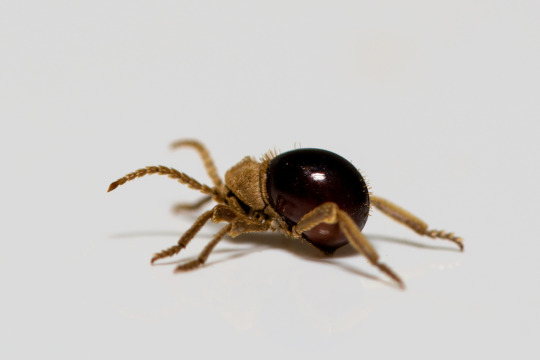
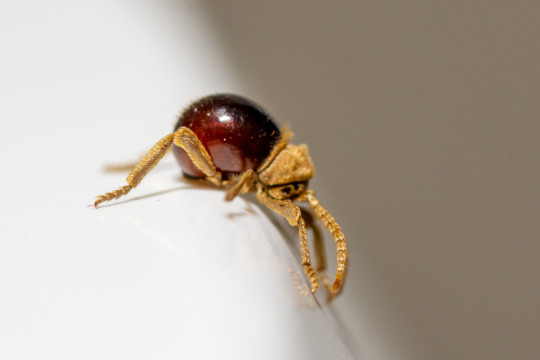
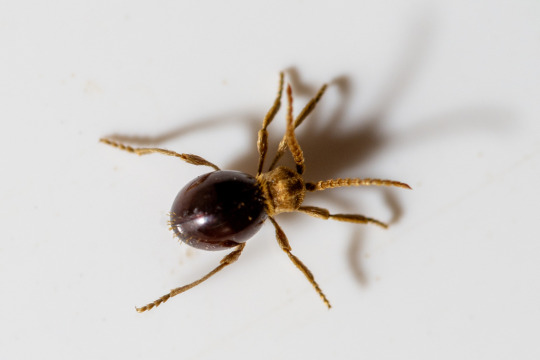
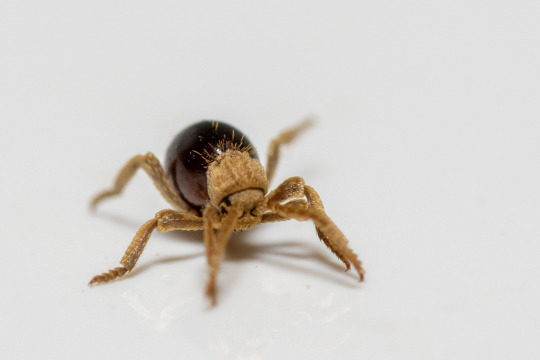

Shiny spider beetle, Mezium affine, Ptinidae
Distributed widely in the Northern Hemisphere and has been introduced to Australia. Larvae are known to infest stored foods of all kinds.
Photo 1 by per-hoffmann-olsen, 2-5 by desislaviliev, and 6 (on finger for scale) by fran86
2K notes
·
View notes
Text
Honeypot ants are fascinating, but feel like something that in concept, is terrifying. And would definitely be a plotline in a Mad Max movie.

These are specalised worker ants that deliberately consume huge amounts of food, to the point where their abdomens will swell to ridiculous sizes. The sclerites (the thickened keratin armour) on their abdomens will separate, revealing the honey inside of their abdominal membrane.
These ants will collect and store liquid which other ants in the colony will then consume, basically functioning as living larders. When they become big enough, they'll hang from the ceiling and can reach the size of a blueberry or a small grape:

They're mostly found in more arid areas of the world; in hot deserts, dry woodlands and other similar habitats (Australia, North Africa, some areas in the Americas etc.). Their existence is likely to allow for colonies to store food during extreme dry seasons, or during periods where food is scarce.
There's been some research indicating that honeypot ants contain unique antimicrobial properties within their honey, which has been used by indigenous people in Australia for centuries!
(Extra note: They also go by repletes or rotunds?? I love scientists.)
Resources and extra reading:
Conway, J. R. (1991). The biology and aboriginal use of the honeypot ant, “Camponotus inflatus” Lubbock, in Northern Territory, Australia. Australian Entomologist, 18(2), 49–56. https://search.informit.org/doi/10.3316/informit.108392124224680
Dong AZ, Cokcetin N, Carter DA, Fernandes KE. (2023). Unique antimicrobial activity in honey from the Australian honeypot ant (Camponotus inflatus) PeerJ, 11:e15645 https://doi.org/10.7717/peerj.15645
National Geographic (2016). Honey Ant Adaptations. Available at: https://web.archive.org/web/20210120124043/https://www.nationalgeographic.org/media/honey-ant-adaptations-wbt/
103 notes
·
View notes
Text


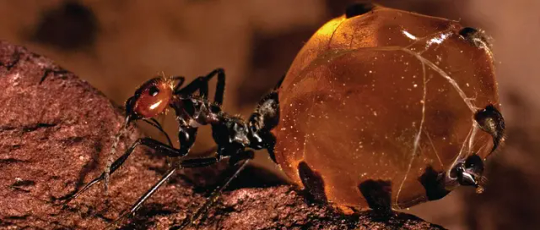
A Sweet Time with the Honeypot Ant
Camponotus inflatus, better known as the Australian honeypot ant or the black honey ant, or the yarumpa or wuukurta ant among Aboriginal Australians, is one of the most well-known members of the honeypot ant group. As their name implies, they are endemic to Australia. They can be found throughout the continent, but are most common in the arid desert and scrubland regions of central Australia.
Honeypot ants, including the Australian honeypot ant, are best known for their specialized worker ants known as repletes. Other castes of workers go out to forage for nectar and honeydew, and bring it back to the colony where it is fed to the repletes. The abdomens of these individuals swell as they are fed, so that they can hold several times their weight in food. In times of shortages, this food can then be regurgitated and fed to the workers and larvae. In addition to its workers, each colony can contain multiple queens; some colonies have been recorded harboring up to 6 queens, presiding over 1,000 workers.
Visually the replete and forager workers are quite similar to each other. Both have black bodies with gold striped abdomens. However workers remain rather small, at only 5-8 mm (0.19 - 0.31 in) in length, while repletes can grow up to 1.4 g (0.03 oz) in weight and about 15 mm (0.59 in) in length. When their abdomens become swollen with honey, they turn transparent to show the amber liquid inside.
Black honey ant nests are most commonly found near or under vegetation, particularly the Mulga bush from which workers harvest most of their food. In addition co collecting nectar from the flowers, workers also collect honeydew secreted by the sap-sucking insects that live in the leaves and roots of the bush. C. inflatus in turn is predated upon by lizards and birds. Many Aboriginal peoples, especially the Tjupan, Mutitjulu, Anangu, Arrernte, and other groups in northern Australia, have also traditionally harvested Australian honeypot ants as a delicacy.
Conservation status: C. inflatus has not been assessed by the IUCN. Its populations are widespread and so believed to be stable. While traditional Aboriginal harvesting has not posed a threat, increased commercial harvest for its pharmaceutical properties may put increased pressure on this species.
Photos
Steve Shattuck
Jean & Fred Hort
Wang & Pan et al.
#Australian honeypot ant#Hymenoptera#Formicidae#carpenter ants#ants#hymenopterids#insects#arthropods#deserts#desert arthropods#scrubland#scrubland arthropods#oceania#australia#north australia#west australia
136 notes
·
View notes
Text
Wet Beast Wednesday: saltwater crocodile
66 million years ago, reptiles ruled the planet, being the largest, most efficient, and most dominant animals. Then a big space rock ruined that and cleared the way for the mammals to take over. Not all reptiles have forgotten their glory days and there are places where they still rule. Meet the saltwater crocodile, the largest and most dangerous reptile in the world and a reminder of their glory days.

(Image: a saltwater crocodile basking in the sun. It is a large reptile with short legs and a large, angular head with massive jaws lined with conical teeth. It has a long tail and its back and tail are lined with rows of scutes. It is a very dark green, almost black, in color. Its mouth is slightly open. End ID)
Crocodylus porosus is the largest crocodilian and largest reptile alive today. They are sexually dimorphic, with the males growing much larger than females. Most males are between 4 and 4.5 meters (13'1" to 14'9") and 408 to 770 kg (899 to 1698 lbs), but they can grow larger in optimal conditions. The largest specimen on record was found dead and estimated to be 6.3 m (20'8") while alive. The largest captive crocodile was named Lolong and weighed in at 6.17 m (20'3") and 1075 kg (2370 lbs). Females typically reach up to 3.4 m (11'2") and 200 kg (440 lbs), with the largest on record being 4.3 m (14'1"). Saltwater crocodiles have the greatest size difference between sexes of any crocodilian and it is thought that this is due to males needing to control a large territory. Saltwater crocodiles, like other crocodilians, are large, amphibious reptiles with large, long jaws and powerful tails that are used to propel them while swimming. Their bodies are covered with scales and scutes, though they have relatively few of the latter compared to other crocodiles. Their heads and bodies are broader than in most crocodiles, leading to an early misidentification of them as a species of alligator.

(Image: a close-up of the head of a saltwater crocodile, showing how high its eyes and nostrils are and its rough, scaly skin. A small leaf had landed in its snout. End ID)
Saltwater crocodiles have a wide historical distribution stretching from eastern India, north to China and Japan, and throughout the Indo-Pacific and Australasia. Overhunting has led to their range being reduced, with many isolated populations. The largest and most stable population is now in northern Australia. They occupy coastal regions and rivers, including mangrove swamps and estuaries. While other crocodile species can tolerate saltwater, only the saltwater crocodile regularly inhabits it. Their ability to tolerate saltwater has helped them get such a large range. The crocodiles can swim out to sea and let ocean currents carry them to new habitats. Tagging and observation has shown that they are powerful swimmers who can venture over 500 km out to sea, they spend most of their time in the ocean simply waiting to be carried to new feeding ground. Those traveling by ocean will occasionally return to land to warm up and wait for the currents to change. Ocean trips can last so long that barnacles can start to grow on their hides. Saltwater crocodiles spend more time in the water than any other crocodile species, but they must return to land to bask in the sun and raise their temperatures. As with other crocodilians, they often bask with their mouths open. The open mouth helps regulate their body temperature. Saltwater crocodiles are typically more active than most other species and spend a lot of their non-basking hours swimming in search of food or to patrol their territory.

(Image: a saltwater crocodile swimming underwater. Its body is skinny when viewed from the side. From this angle, its lighter underbelly is partially visible. End ID)
Saltwater crocodiles are opportunistic predators that will eat just about anything. Juveniles are restricted by their size and feed on fish, crustaceans, molluscs, birds, and small mammals. As they grow, their diet expands to larger animals such as dingos, emus, deer, boars, and primates. The larger males can take prey as large as water buffalo. Even the largest male will still take small food if the opportunity arises and they have shown some resistance to the poison of the highly invasive cane toad. As with other crocodilians, saltwater crocodiles are ambush predators. They tend to sit very still, allowing them to be mistaken for sunken logs and their eyes and nostrils are high on their heads, letting them keep most of their bodies submerged. When prey comes along, they will attack with their powerful jaws. Saltwater crocodiles have the most powerful bite force of any living animal and their teeth can be up to 13 cm (5 in) long. Prey not killed by the initial bite will be dragged into the water. Crocodiles practice the death roll, a habit of spinning themselves around while biting onto prey to dismember it. Food can be dragged underwater and stored until it starts to rot to make eating easier. Saltwater crocodiles have also been known to jump vertically out of the water to attempt to catch flying prey like birds and bats. They also also been known to use these leaps to try to knock monkeys and gibbons off of overhanging branches and into the water. While out at sea, the crocodiles will feed on marine animals as large as dugongs and sharks. Saltwater crocodiles, especially males, are highly territorial and will fight to defend their feeding grounds. Because of their slow metabolism and lethargic lifestyle, crocs can go months between meals.

(Image: a saltwater crocodile launching itself vertically out of the water to attempt to grab food that is being dangled above it. The front half of its body is sticking out of murky water and its mouth is wide open. End ID)
Saltwater crocodiles mate during the wet season, when temperatures and water levels are rising. Females will select the nesting site, which is usually a stretch of muddy shoreline. She then lays her eggs in an excavated pit and buries them under a mound of soil and vegetation that helps keep them warm. The clutch usually numbers 40 to 60 eggs, but can reach up to 90. The mother will remain near the nest until hatching, which can be over 100 days. When they young are close to hatching, they will emit yelping cried that triggers the mother to dig them out and even help hatch them by gently manipulating the eggs in her mouth. Once hatched, she will carry her young to the water and remain with them for around 8 months as they grow. Despite the protection of the mother, the eggs and juveniles are highly vulnerable to flooding and predation and only 1% of laid eggs will reach adulthood. Once they reach about 2 and a half years, the juveniles will begin to display territorial behavior and will stop associating with other members of their species. Females reach sexual maturity at around 12-14 years and males around age 16. They have a very long lifespan, with reports of crocodiles reaching ages of 70 and older. Most mature females will mate one a year and they do not show mate fidelity.

(Image: a juvenile saltwater crocodile basking on a log. It share the body shape of an adult, but its scales are a light, sandy color with dark patched. Its mouth is open. End ID)
Saltwater crocodiles are considered least concern for global extinction, but they are vulnerable to local extinction in many parts of their range. Habitat loss and poaching are major threats to them. Saltwater crocodiles are hunted for their meat, eggs, and skin, and poaching in a problem in large parts of their range. The most stable population exists in northern Australia due in part to conservation efforts and populations of feral goats, pigs, and buffalo that serve as a plentiful food source. Saltwater crocodiles are one of the few crocodiles that will eat humans. In fact, they are the species most likely to treat humans as prey. Their size and ambush tactics make them highly dangerous when attacking and they are likely to treat people entering their territory as threats. Males are more likely to be dangerous than females. Relocating problem crocodiles is generally ineffective s they or another crocodile usually find they way back to the now empty territory. The best way to avoid attacks is to stay out of their territory. In Australia, warning signs around crocodile habitat have been shown to be effective at reducing attacks. There are an average of 2 fatalities a year in Australia and attacks in other countries usually go under reported. Negative public opinion of the crocodiles has hampered conservation efforts as they are often attacked in revenge killings.

(Image: a saltwater crocodile basking with a radio tag attached to its back, the antenna sticking up. In the background is famous animal conservationist Steve Erwin, laying down in the water and looking toward the camera. End ID0
#wet beast wednesday#saltwater crocodile#crocodile#crocodilian#reptile#reptiles#aquatic#freshwater#saltwater#estuary#australia#biology#zoology#ecology#herpetology#nature#animal facts#informative#educational#image described
75 notes
·
View notes
Text
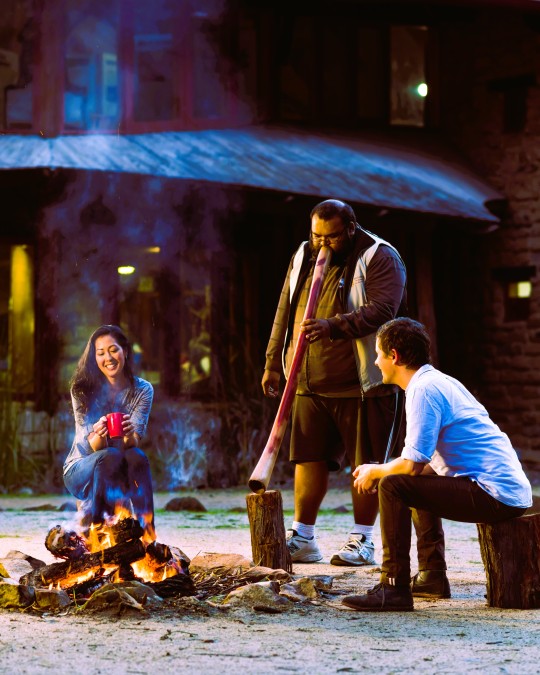
Brambuk National Park & Cultural Centre, Halls Gap, Australia: This award winning centre offers visitors extensive information on the local Aboriginal Culture, history, rock art sites, and the natural environment as well as servicing the needs of visitors to the Grampians National ParkBrowse the displays, take part in tours & activities, and view the Dreamtime creation story of the area. The on-site Gift Shop offers a range of quality products and the Bush Tucker Café serves delicious food and great coffee! Halls Gap is a town in Victoria, Australia. It is located on Grampians Road, adjacent to the Grampians National Park, in the Shire of Northern Grampians local government area. Wikipedia
#Brambuk National Park & Cultural Centre#Grampians#Halls Gap#Victoria#Australia#oceania#oceania continent
99 notes
·
View notes
Text
Prehistoric kangaroos in southern Australia had a more general diet than previously assumed, giving rise to new ideas about their survival and resilience to climate change, and the final extinction of the megafauna, a new study has found. The new research, a collaboration between paleontologists from Flinders University and the Museum and Art Gallery of the Northern Territory (MAGNT), used advanced dental analysis techniques to study microscopic wear patterns on fossilized kangaroo teeth. The findings, published in Science, suggest that many species of kangaroos were generalists, able to adapt to diverse diets in response to environmental changes.
Continue Reading.
59 notes
·
View notes
Text
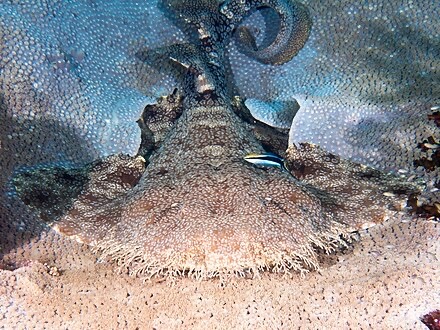
this odd little goober^^ is called a tasselled wobbegong and is 1 of 12 species of carpet shark in the orectolobidae family (wobbegong being the common name). orectolobidae are found in shallow, temperate and tropical waters of the western pacific ocean and eastern indian ocean, mainly around australia and indonesia. however, one, the japanese wobbegong, strays from this pattern by going as far as japan!
the 12 types of wobbegong are: tasselled, floral banded, gulf/banded, western, japanese, indonesian, spotted, ornate, dwarf spotted, network, northern and the cobbler wobbegong.
the reason for their classification as "carpet sharks" is of course related to their resemblance of ornately patterned carpets but also because they all have 5 gill slits, two spineless dorsal fins and a small mouth that doesn't extend past the eyes, as most of the species have barbels- small whiskerlike organs near the mouth which house taste buds and search for food in murky waters.
the tasselled wobbegong's arguably most distinctive trait is its fringe of branching dermal flaps around the head, which dribble onto its chin. the fringe enables the tasselled wobbegong to camouflage itself against the reef environment. this is done by the complex colour pattern of small blotches and reticulations (a pattern of interlacing lines resembling a net). their colour can actually change colour slowly over the course of several days to blend in with it's environment.
also, they're a nocturnal species and are only active at night. they're solitary snd spends most of the day resting in caves, under ledges, with their tail curled up around them. think of a really odd, kind of distorted and funny looking cat! similar, right? individual tasselled wobbegongs will have what's referred to as a small "home range". these areas contain several preferred resting spots which are used repeatedly.
wobbegongs primary diet is bottom-dwelling fish (mainly the bony type) and invertebrates such as small octopi, crabs or lobsters. when it hunts, they perch on reef and lunge up to suck in its prey. it then clamps down with its large jaw and fang-like teeth, not letting go until it's successfully killed its prey. the tasselled wobbegong is very opportunistic as it tends to remain in its favoured resting spot and whilst it's lounging, it'll ambush its prey. however, the little carpet also has its predators! this includes sharks- like the blacktip reef, horn, nurse, sand tiger and sand shark-, larger fishes and marine mammals.
these guys tend to reside in shallow habitats (ranging from 5 to 50 metres, 160 feet) near coral reefs! they're found in the tropical waters of the indo pacific ocean off of indonesia, australia and new guinea.
the maximum size of this species has been found to be 1 metre (4 feet) and it's complete lifespan is actually unknown but estimated to be about 26 years, between the average shark lifespan. this species has a very broad and flattened body and head, hence the carpet nickname.
we don't actually know much about the biological structure of the tasselled wobbegong but it's assumed to be a viviparous species (give birth to live young) based off of the reproductive habits of similar and related species. the pups are kept inside the womb of the female wobbegong in the form of eggs until they hatch and the young get their nourishment from the egg yolk. in a litter, there's typically 20 or more pups at a time. all measuring to about 20cm long (8 inches). their size at sexual maturity, however, is uncertain. their mating has been reported to have been observed in a cave at night, but not much else is known. one male, adult, was found to be adult at 1 metre - the average tasselled wobbegong size.
compared to other wobbegongs, the tasselled wobbegong is notorious for its "unprovoked attacks" on humans. whilst the species has certainly proved that it's capable of inflicting severe wounds, divers have also been able to approach the species without incident. given the sharks camouflaged appearance and poor vision, it's recommended people avoid accidentally harassing the shark as it will mistake a foot or hand as prey.
this carpet shark doesn't actually have a great economic value. although it's peculiar skin may occasionally be used for leather, it's not fished in australian waters and faces minimal threats. however, elsewhere, it may very well be affected by excessive fishery activity and habitat degradation (loss) from pollution, blast fishing (an illegal method involving explosives to stun/kill schools of fish) and coral removal. regarding this, the ICUN has declared this species of shark as least concern. meaning that it's still plentiful in the wild and isn't considered threatened or,pre 2001, conservation dependant.
note: ive came to the realisation that the previous image shown was a monkfish, not a tasseled wobbegong. i apologise for the misinformation! ive changed/updated the image since! very sorry
#shark#facts#fun facts#i love sharks#tasselled wobbegong#marine biology#marine life#ocean#special interest#science#biology#sea creatures#sea life#love to sea it#oceanposting#sharkblr#sharks
144 notes
·
View notes
Text
Check Darwin Unveils $100M Ag Plan for Australian Farmgate Output
NFF outlines a $100M Ag production strategy in Darwin to elevate Australian Farmgate output. It targets renewable farm sheds and farming, safety, and workforce growth. Visit our website to learn more about agriculture production and sheds.
#Ag production outlined in Darwin#Australian Farmgate output#Northern Australia Food#National Farmer’s Federation#Agriculture production#farm shed#agriculture shed
0 notes
Text
As I promised to update, I'm back from the hospital and I'm okay.
Food was starting to run out (only had enough left for about half a day), I really didn't want to go to the store when it's dangerous to be away from the bomb shelter, but had no choice. Got food, but there's no bottled water to be found anywhere, exactly when Israeli citizens were instructed last night to stock up our bomb shelters with enough dry food and bottled water for at least three days.
The number of confirmed dead is officially at 900 (still not final), the number of wounded is at over 2,600, the number of kidnapped is at least 150. The number of terrorists who breached Israel's border and massacred civilians on Saturday is estimated to be at least 1,500.
I mentioned Mor and her grandmother already, but I felt like hearing her telling their story is important enough to share this vid. Testimonies like this are coming out in incomprehensible numbers.
Since the beginning of this war on Israel on Saturday, five independent terrorist attacks were attempted and stopped. Thankfully, no one was reported to have been murdered, though there are casualties.
In Egypt, a soldier guarding tourists (likely inspired by Hamas' massacre) opened fire at a group from Israel. He murdered two Israelis and their Egyptian local tour guide. At least one more person was also wounded in this terror attack.
There have been rockets fired into Israel from the north by Hezbollah (while Hamas fires thousands of rockets from the south) and there was also a breach of Israel from the north by another terrorist organization named Islamist Jihad. During this, Israel's northern citizens were instructed to lock themselves inside their homes. All of the terrorists who infiltrated Israel from the north were killed, but so was an Israeli commander, Alim Abdallah. He was supposed to finish his army service this coming Sunday. May his memory be a blessing.
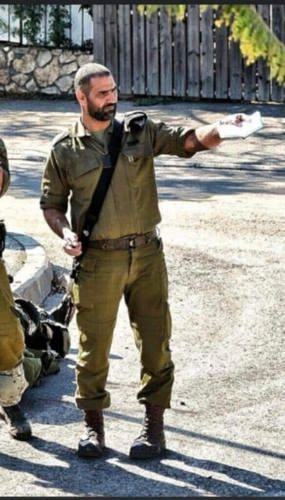
On a personal note, my former boss' son was killed (may his memory be a blessing. ז"ל), and one of my colleagues has been kidnapped and is held hostage in Gaza.
Another personal story is that of Lior Asulin. He was a talented soccer player. Among other clubs, he played for an Arab team and helped it become Israel's soccer champion. He was murdered at the music festival that he went to in order to celebrate his birthday, and where at least 270 young people were butchered (ז"ל).
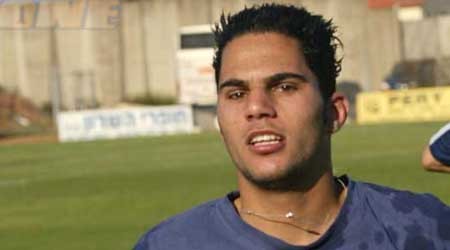
There's news from other countries about anti-Israeli demonstrations where the massacre of innocent Israelis is celebrated, in Australia the pro-Palestinian demonstrators shouted "Fuck the Jews" as well as "Gas the Jews."


In at least one protest a pro-Israeli demonstrator was beaten up:
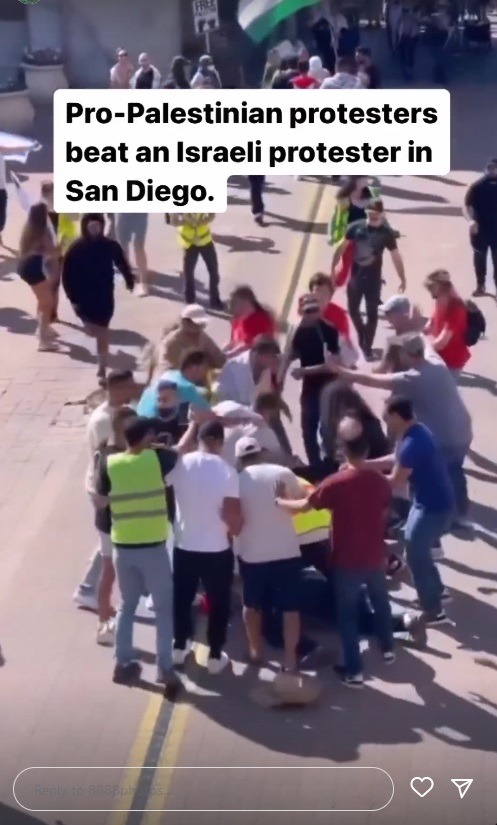
And already there are antisemitic incidents, where Jewish establishments outside of Israel are being targeted.

Countries whose citizens are known to have been kidnapped or murdered by Hamas in the attack on Israel:
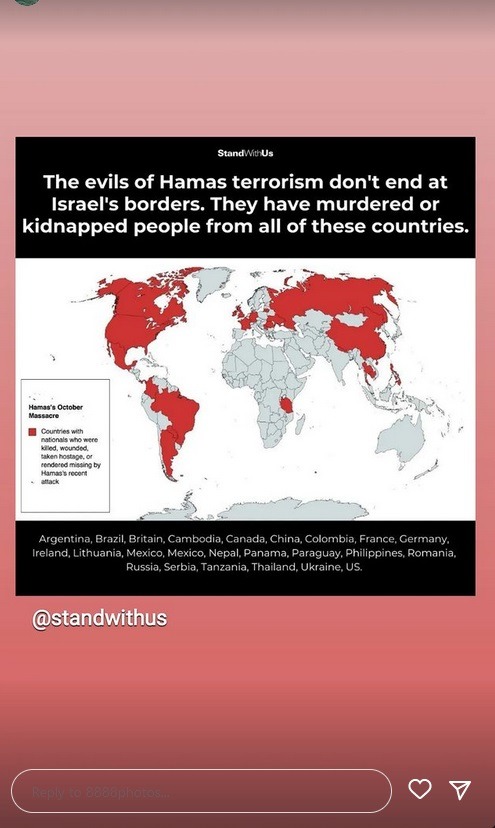
(for all of my updates and ask replies regarding Israel, click here)
#israel#israeli#israel news#israel under attack#israel under fire#israelunderattack#antisemitism#jewish#jews#jew#judaism#jumblr#frumblr
460 notes
·
View notes
Text
Emergency: Help Evacuate My Family From GAZA WAR
Dear Humanity,
I'm Hossam from Gaza , from a family of 4 people: my mam and two daughters .
I've witnessed the evidence of the tragedy that has struck our lives in Gaza, where my family and I have survived amidst numerous previous wars. But today, we face the most dangerous and fierce battle in the current war. The urgent need intensifies for us, as we have nothing left and are unable to secure our basic needs such as food, water, and safe shelter.
Here is our story - On October 7th, our lives changed forever, my family and I evacuated from northern Gaza to southern Gaza, hoping to return soon, but it wasn't meant to be. Our home was surrounded, burned, and then completely destroyed, Our home, once a fortress of hope, now lay in ruins, a stark reminder of our shattered dreams.
The night before we left from the north to the south was terrifying. Shelling sounds were everywhere, making a loud noise that felt like it went through our souls. Every explosions shook the ground like earthquakes, sending shockwaves of fear through our trembling bodies. filling us with fear. The air smelled of destruction and blood, making it hard to breathe. When dawn came, we saw the devastation around us, realizing our home was now a symbol of loss and despair.
I was looking at the faces of the people around me, old and young, everyone was scared, everyone was trembling, everyone was asking about his fate.
Everyone is asking where we are going who will receive us if all the houses we know are demolished.
We had nothing but the path of danger, either we walk it and see what the end of this road is, or we stay hidden and expose ourselves to greater danger.
We ran into the streets and with each step we took into the unknown streets, we felt as if we were plunging deeper into the abyss of our shattered existence, leaving behind everything we own in our home: Clothes, important official documents, the car, and literally it's almost everything - the enormity of our loss weighed heavily upon us.
The number around us started to decrease, there was only a little left. I look at the clock and I see it approaching the morning hours. My family and I were walking, burdened with fatigue and sadness. We looked and saw us. When the rockets rained on the place where we were, we walked a distance of at least 14 kilometers. Then we reached another house. We entered. Everyone washed his hands. We stayed for a while. And the people around us rushed and raced. So we left the house, where we only sat for a period not exceeding an hour. We went to the hospital to hide there a week later the second house was demolished and we were literally nothing.
The hospital, which houses more than 20,000 people, has become our home where we sleep, eat, and do our needs before. Before the seventh of October, one of us used to shower at the time he wanted and wash his clothes at the time he wanted. Then we washed once or twice a week, if we could and we were injured, we washed our clothes once or twice, and they were spread on the roof of the hospital, and the sounds of shelling and bullets sent fear inside us.
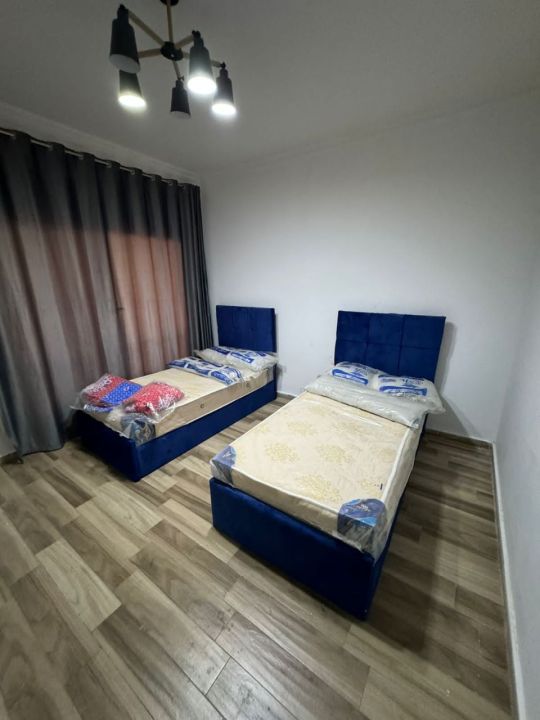
Before the seventh of October we slept here
And then we slept here.
We used to dry our clothes in our private house safely and reassuringly without seeing anything for others and no one seeing us.
But then we were under the whiz of bullets, doing that, and I will attach a video clip that you will find on my page.
I appeal to the world as a whole to hear my cry and the mournful cry of my family in Gaza. We need the helping hand that reaches out to wipe our tears and build a bridge to safety.
Your donation is not just a donation; it's an opportunity to rebuild life and brighten a better tomorrow. Be part of our hopeful story, for we need your hand to start anew.
And that's why we seek salvation, we hope that you become our salvation, help us survive by donating, every tear counts, every feeling matters, and every soul is sacred.
Your donation means the world to us!
#free palestine#donations#donate if you can#please donate#gofundme#go fund them#donate#donation#go fund her#palestine gfm#gaza gfm#gazan families#fundraising#go fund me#fundrasier#save gaza#save palestine#please#please help#help gaza#mutual aid#donation match#charity#go fund him#gaza#gaza strip#emergency#hope#important
68 notes
·
View notes
Text
Round 3 - Mammalia - Dasyuromorphia




(Sources - 1, 2, 3, 4)
As marsupials finally made their way into Australia they began to diversify even further. The order Dasyuromorphia represents the vast majority of “carnivorous marsupials”, marsupials which fill the niches of the placental carnivorans. This order contains the living families Dasyuridae (mulgaras, Kaluta, Kowari, quolls, dasyures, Dibbler, marsupial shrews, antechinuses, phascogales, planigales, Kultarr, ningauis, dunnarts, and the Tasmanian Devil) and Myrmecobiidae (the Numbat). Famously, this order also contained the extinct Thylacine (Thylacinus cynocephalus).
Most Dasyuromorphs are small and mouse or shrew-like, though the group also contains the cat-sized quolls and Tasmanian Devil (Sarcophilus harrisii) (image 2). They have many features considered primitive to marsupials, such as seperate toes (in many other marsupials, the second and third toes are fused) and some lack a full pouch. Instead, many species have a simple fold of skin surrounding the teats, to provide some protection to the developing young. Dasyuromorphs are primarily insectivorous, but they will also eat small lizards, birds, frogs, mammals, fruit, nectar, and flowers. One of the few exceptions to this rule is the Tasmanian Devil, which subsists mainly on carrion but can feesibly take on prey up to the size of a small kangaroo. Adult dasyuromorphs are typically solitary, or travel in small groups of two to three individuals.
As in other marsupials, dasyuromorph joeys are born as relatively undeveloped “jellybeans” and must crawl their way from the vagina to the pouch or teat and latch on. Once the young makes contact with the nipple, it expands, locking the joey in place and ensuring it doesn’t fall off the mother or out of the pouch while they finish their development. Smaller dasyuromorphs generally reproduce at least twice a year, but the larger Numbat, quolls, and Tasmanian Devil generally only have one litter a year.
Dasyuromorphs have existed since the Late Oligocene, 33 to 23 million years ago.

Propaganda under the cut:
Quolls (image 1 and gif) are sometimes referred to as "native cats" and occasionally "marsupial cats" or "tiger cats", due to their cat-like size and behavior.
Although they are nocturnal, the New Guinean Quoll (Dasyurus albopunctatus) is known to spend its daylight hours basking in the sun.
The Paucident Planigale (Planigale gilesi) is also nocturnal and enters a state of torpor in unfavourable conditions to reduce energy expenditure in times of inactivity. However, it also exhibits basking or sunning behavior as an energy-conserving strategy. The Paucident Planigale is the smallest mammal to display basking behavior in the wild in order to reduce energy requirements, particularly in winter.
The Western Quoll (Dasyurus geoffroii) is at the top of the food chain in Western Australia, and eats lizards, birds and their eggs, frogs, spiders, insects, and small mammals, even bandicoots, parrots, and invasive rabbits.
The current major threat to the endangered Northern Quoll (Dasyurus hallucatus) is the spread of the Cane Toad (Rhinella marina). Native to South and mainland Central America, the Cane Toad was introduced by European colonists as biological control of agricultural pests in 1935. The toad was unsuccessful at controlling the targeted cane beetles, but was successful at spreading across Australia and poisoning many of its native predators, who had not evolved alongside the toad to develop a resistance to its toxins or aversion to its taste, and did not recognize it as poisonous. Like many other native Australian predators , Northern Quolls are poisoned after eating or mouthing cane toads. Immediately after the Cane Toad invasion of Kakadu National Park, Northern Quolls became extinct at one study site and declined from 45 individuals to 5 at another site. The Northern Quoll may cease to exist in most areas in the Top End once the Cane Toad population completely overlaps the Northern Quoll's range. Scientists sought to reintroduce quolls who had been trained to avoid the toads, and released them into the park. This was at first successful, however, the quolls had lost their ability to recognise and avoid both feral dogs (dingo) and cats due to being raised in human care, and the population was lost again. Some Northern Quolls persist in Queensland, and seem to naturally be “toad averse,” as well as on islands where the toads have not reached.
The smallest dasyuromorph is the Pilbara Ningaui (Ningaui timealeyi), which is also the smallest of all marsupials, and one of the smallest mammals, averaging 4.5 to 5.8 cm (1.8 to 2.3 in) in body length.
Another tiny dasyuromorph is the Long-tailed Planigale (Planigale ingrami), which averages 5.9 cm in body length and weighs 4-6g. Despite this, it is an active and fearless hunter, preying mostly on insects and their larvae, small lizards, and young mammals almost as large as itself. With larger prey like grasshoppers, an initial pounce is often insufficient and the planigale bites repeatedly until the prey stops struggling.
Following the extinction of the Thylacine in 1936, the Tasmanian Devil (Sarcophilus harrisii) became the largest carnivorous marsupial in the world.
The Tasmanian Devil's large head and neck allow it to generate among the strongest bites per unit body mass of any living predatory land mammal, with a Bite Force Quotient of 181 and exerting a canine bite force of 553 N (124 lbf). The jaw can open to 75–80 degrees, allowing the devil to generate a large amount of power to tear meat and crush bones; sufficient force allows it to bite through thick metal wire. The teeth and jaws of Tasmanian Devils resemble those of hyenas, an example of convergent evolution.
The first European Tasmanian settlers ate Tasmanian Devil, which they described as tasting like veal. As it was believed devils would hunt and kill livestock, a bounty scheme to remove the devil from rural properties was introduced as early as 1830. In areas where devils were eradicated, poultry continued to be hunted by quolls. Over the next 100 years, trapping and poisoning brought Tasmanian Devils to the brink of extinction. More than 900,000 Tasmanian Devils were hunted in 1923—and this resulted in a continuation of bounty hunting of devils as they were thought to be a major threat to the fur industry, even though quolls were more adept at hunting the wallabies and possums typically hunted for fur. After the death of the last Thylacine in 1936, a conservation wake-up call, the Tasmanian Devil was finally protected by law in June 1941 and the population slowly recovered.
Since the late 1990s, devil facial tumour disease (DFTD) has drastically reduced the population of Tasmanian Devils and again threatens the survival of the species, which in 2008 was declared to be endangered. This aggressive, non-viral, clonally transmissible cancer manifests itself as lumps of soft and ulcerating tissue around the mouth, which may invade surrounding organs and metastasise to other parts of the body. DFTD is most often spread by bites, when teeth come into contact with cancer cells. It can also be spread by ingesting of infected carcasses and sharing of food. Adult Tasmanian devils who are otherwise the fittest are most susceptible to the disease. Starting in 2013, Tasmanian Devils are being sent to zoos around the world as part of a Tasmanian Devil conservation and breeding program.
Tasmanian Devils are fully grown at two years of age, and few devils live longer than five years in the wild. Possibly the longest-lived Tasmanian Devil recorded was Coolah, a male devil which lived in human care for more than 7 years. Born in January 1997 at the Cincinnati Zoo, Coolah died in May 2004 at the Fort Wayne Children's Zoo.
Male Little Red Kalutas (Dasykaluta rosamondae), all antechinuses, and many other small dasyurid species die shortly after a frenzied breeding season, probably due to stress or exhaustion. In human care, males can live from 2 to 5 years, but will no longer be able to reproduce after their first year.
The Numbat (Myrmecobius fasciatus) was once widespread across southern Australia, but after the deliberate release of Red Foxes (Vulpes vulpes) by European colonists for sport hunting, the entire Numbat population in Victoria, NSW, South Australia and the Northern Territory, and almost all Numbats in Western Australia were wiped out. It is now restricted to several small colonies in Western Australia. By the late 1970s, the population was well under 1,000 individuals. An intensive research and conservation program since 1980 has succeeded in increasing the Numbat population substantially, and reintroductions to fox-free areas have begun. Perth Zoo is very closely involved in breeding this native species in captivity for release into the wild.
As an adaptation to a diet consisting almost entirely of termites, the Numbat has a long, sticky anteater-like tongue which it uses to catch its prey. Although the Numbat finds termite mounds primarily using scent, it has the highest visual acuity of any marsupial, and, unusually for marsupials, has a high proportion of cone cells in the retina.
Every night the Fat-tailed Dunnart (Sminthopsis crassicaudata) consumes approximately its own body weight in food. During periods of food shortage it decreases its duration of activity while also increasing its intensity of feeding. It uses specialized, sharp teeth to grind its prey into fine pieces.
The Thylacine (Thylacinus cynocephalus) was the last of the Thylacinids, a family of dasyuromorph marsupials. It lived from the Pleistocene to the Holocene in Australia and New Guinea, driven to extinction in the 1930s by hunting, human encroachment, disease, and feral dogs (dingos). The Thylacine was already extinct on the Australian mainland and New Guinea by the time European settlers arrived, with the island of Tasmania being its last stronghold. Settlers feared the marsupial would attack them and their livestock, demonizing it as a “blood drinker”, and bounties were put in place that drove the Thylacine to be overhunted. As they became rarer, there was a push to capture Thylacines and keep them alive in captivity, but unfortunately it was too little, too late. Conservation and animal welfare was not at the level it is today, not much was known about their behavior in the wild, and there was only one successful birth in captivity. Studies show that with continued successful breeding, a campaign to change public perception, and protections put into place much earlier, the Thylacine could have been saved. But the last captive Thylacine died in 1936, and official protection was not put in place until that year, 59 days before his death. Sightings continued into the 1980s, and even today some claim to see them, but all of these sightings are unconfirmed and unlikely. The Thylacine is definitively extinct. Today, carnivores such as wolves and coyotes are demonized in the same way the Thylacine was, and there are some who wish to also wipe them out entirely, even having succeeded in many places. While some of the Thylacine’s closest relatives, like the Numbat and Tasmanian Devil, survived the European persecution which killed off the Thylacines, they are still endangered today due to introduced predators and disease. Instead of continuing to search for, or trying to resurrect the lost Thylacine, perhaps it is best we channel that attention, love, and regret onto the species we still have. Extinction is forever, and it is easier to save those who are still alive.

(source)
#i apologize for reusing my spiel from my Thylacine post on my paleoart account but I think it’s very important#stop trying to de-extinct species when those resources could be better used on species we still have and have a better chance of saving#animal polls#round 3#mammalia
103 notes
·
View notes
Text

Researchers have discovered a new species of rove beetle that grows a termite puppet on its back to fool real termites into feeding it. The replica is so precise, it even mirrors the termites’ distinct body segments and has three pairs of pseudo-appendages that resemble antennae and legs.
The new beetle species (Austrospirachtha carrijoi)—found beneath the soil in Australia’s Northern Territory—emulates a termite by enlarging its abdomen, a phenomenon known as physogastry. Evolution has reshaped this body part into a highly realistic replica of a termite (as seen above), head and all, which rides on top of the rest of the beetle’s body. The beetle’s real, much smaller head peeks out from beneath its termite disguise, the authors report this month in the journal Zootaxa. The termite “puppet” may help the beetle evade detection—though termites are blind, they sense one another through touch.
Because A. carrijoi’s mouth parts are tiny, the authors think it begs food from its hosts rather than eating eggs or larvae. Worker termites feed other castes digested food in a process called trophallaxis. This adaptation has obvious advantages to the beetle. Once it is inside the nest, it can relax and spend the rest of its life living off of termite room service.
Words by Richard Pallady
327 notes
·
View notes
Note
Top 5 archaeological sites in Australia that you feel people should know more about? Or top 5 Australian artefacts?
I feel like I’ve talked a bit about artefacts in a few recent asks, and also I feel like a lot of Australian archaeology (and as such, sites) are very underrated, particularly on a global scale. Its often acknowledged in Australian archaeology that getting international academia to recognise the importance of our country’s archaeology is very very difficult.
While there’s a million and one sites I’d love to talk about, I’m going to TRY and give sites that relate to different aspects and locations
This is probably going to be long, so...
1. Nauwalabila, Madjedbebe (Malakunanja II), and the Deaf Adder Gorge region, Northern Territory (Aboriginal)
Rock shelters in this region, and specifically Madjedbebe, are currently the oldest location of human habitation in Australia. Dating evidence from 2017 excavations provided an estimate of earliest occupation of 50 000 years at certainty, possibly extending back as early as 65 000 (+/-6000). It also has provided a lot of evidence for research into the extensive grind stone technologies of the Pleistocene.

2. Cloggs Cave and the Buchan region of the Victorian Gippsland (Aboriginal)
So much research has been done into this region in various ways. Josephine Flood focused her research on Bogong Moth usage (and festivals) within this region, providing some of the earliest accepted academic research in support of Aboriginal peoples’ claims of large scale Bogong Moth Festivals in Australia’s highlands (although the fac that no one really believed communities until then…………..). In 2021 grind analysis found Bogong Moth residue, making this the earliest stone artefact with evidence of insect food remains. And in addition to that recent 2017 research in the area investigated Holocene occupation with Aboriginal community members, with a focus on understanding the interaction of spirituality with the resources found in the caves.

3. Mabuyag Island, Torres Strait Islands, Queensland (Torres Strait Islander)
Mabuyag Island (alternatively known as Mabuiag or Mabuyaagi) has archaeological evidence of human occupation since 7300 years ago. The island is both associated with recent religious practices associated with he heavy processing of dugong remains, and totemic associations with these, which played a role in early 2000s into community lead and directed archaeological research into ritual and religious traditions and practices. In addition to this, Mabuyag is the location of the first archaeological excavations in Australia to find pre-colonial pottery fragments. The fragments at the two sites on the island were associated with Melanesian and Papua New Guinean pottery trade. The excavations relating to pottery on the island played an important role in our understanding of domestic and international trade in pre-colonial Australia, and also formed an influence for the recent excavations at Lizard Island, 300km south, which identified the first datable domestically made pottery technology found in Australia.

4. Hyde Park Barracks, Sydney, NSW
Hyde Park Barracks is part of a collection of colonial heritage structures in Australia, relating to Australia’s time as a penal settlement. Hyde Park Barracks in particular were the location of the housing of convict men from 1819 to 1830, with the 1830s to 1840s also involving the site being a location of additional convict punishment, and the base for the Board of Assignment of Servants. Following on from a reduction of convicts to NSW in the 1840s, the Barracks became the Female Immigration Depot, and the Orphan Institution, later becoming the Asylum for Infirm and Destitute Women.
This time period of women’s occupation provides some of the most interesting archaeological remains, as redevelopment and management of the site has found high rates of preservation within walls, and in areas below floorboards. This includes textiles and fabrics, papers, and other non-organic materials such as pipes (with their tobacco intact) stashed in what was once floor, wall, and ceiling cavities. Archaeological investigations in the area form one of the most detailed assemblages of artefacts relating to instituted women in the British Empire during the 19th century.



5. Notch Point, Western Australia (Multicultural heritage)
Notch Point is a site of varied and mixed archaeology, ranging from pre- and post- colonial period Aboriginal heritage, to diverse 19th century occupation of the region by Chinese, European, Malay, and Aboriginal peoples in association with pearling industries off the coast. In addition to this, the point is located on Dirk Hartog Island (otherwise known as Wirruwana), the site of the earliest European arrival in Western Australia in 1616, and contains archaeological evidence of both various early Dutch interactions with the island in 1616 and 1697, as well as French arrival in 1772, 1801, and 1818. Notch Point in particular also contains evidence of conflict between the predominantly Chinese population of the pearling industry, with white-Australian and European pearling masters, and pastoral agents. Its not a site that is widely discussed, but provides a fascinating overlay of the amount of varied cultural groups that can be present within Australia’s archaeological sites.

-
-
Honourable mentions to:
Lake Mungo and the Willandra Lakes which should 100% be on this list, but also I feel like I talk about it ALL the time and I wanted to mention sites that I actually don’t see discussed a lot. Theyre super important for cultural reasons, for archaeological reasons, and also for their role the development of archaeology, Aboriginal community consultation, and the role its played in developing repatriation practices in modern Australia. I have multiple posts about them HERE
Budj Bin Eel Traps in Victoria (same reasons, I’ve definitely talked about them before).
Juukan Gorge (and its destruction, im still horrified)
Harrietville Chinese Mining Village
Strangway Strings and The Peake Afghan Cameleer sites
Recherche Bay in Tasmania, and its 1792 French settlement sites
Homebush Mill & Mission Hall in QLD and Beowa National Park sites containing South Sea Islander heritage
#I feel like this constitutes a solid answer#i had fun#and hopefully people learn new things about Australian archaeology#and its diversity#sorry this took literally forever to answer#i got sick for a bit#and then its going to chill in my queue for a couple of days#archaeology#Australia#aboriginal and torres strait islander peoples#they let a mouse do archaeology?#Mice answers things
73 notes
·
View notes